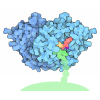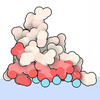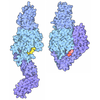[English] 日本語
 Yorodumi
Yorodumi- PDB-7tpp: Cryo-em structure of human prothrombin:prothrombinase at 4.1 Angs... -
+ Open data
Open data
- Basic information
Basic information
| Entry | Database: PDB / ID: 7tpp | ||||||
|---|---|---|---|---|---|---|---|
| Title | Cryo-em structure of human prothrombin:prothrombinase at 4.1 Angstrom resolution | ||||||
 Components Components |
| ||||||
 Keywords Keywords | BLOOD CLOTTING / prothrombin prothrombinase | ||||||
| Function / homology |  Function and homology information Function and homology informationresponse to vitamin K / coagulation factor Xa / platelet alpha granule / Cargo concentration in the ER / Defective factor IX causes thrombophilia / Defective cofactor function of FVIIIa variant / Defective F9 variant does not activate FX / COPII-coated ER to Golgi transport vesicle / Extrinsic Pathway of Fibrin Clot Formation / COPII-mediated vesicle transport ...response to vitamin K / coagulation factor Xa / platelet alpha granule / Cargo concentration in the ER / Defective factor IX causes thrombophilia / Defective cofactor function of FVIIIa variant / Defective F9 variant does not activate FX / COPII-coated ER to Golgi transport vesicle / Extrinsic Pathway of Fibrin Clot Formation / COPII-mediated vesicle transport / blood circulation / cytolysis by host of symbiont cells / thrombospondin receptor activity / Defective factor XII causes hereditary angioedema / thrombin / thrombin-activated receptor signaling pathway / negative regulation of astrocyte differentiation / regulation of blood coagulation / positive regulation of phospholipase C-activating G protein-coupled receptor signaling pathway / neutrophil-mediated killing of gram-negative bacterium / Defective F8 cleavage by thrombin / Platelet Aggregation (Plug Formation) / ligand-gated ion channel signaling pathway / positive regulation of collagen biosynthetic process / negative regulation of platelet activation / negative regulation of blood coagulation / positive regulation of blood coagulation / negative regulation of fibrinolysis / positive regulation of TOR signaling / regulation of cytosolic calcium ion concentration / Transport of gamma-carboxylated protein precursors from the endoplasmic reticulum to the Golgi apparatus / Gamma-carboxylation of protein precursors / Common Pathway of Fibrin Clot Formation / Removal of aminoterminal propeptides from gamma-carboxylated proteins / fibrinolysis / Intrinsic Pathway of Fibrin Clot Formation / negative regulation of proteolysis / endoplasmic reticulum-Golgi intermediate compartment membrane / negative regulation of cytokine production involved in inflammatory response / Peptide ligand-binding receptors / platelet alpha granule lumen / Regulation of Complement cascade / positive regulation of release of sequestered calcium ion into cytosol / acute-phase response / Cell surface interactions at the vascular wall / positive regulation of receptor signaling pathway via JAK-STAT / Post-translational protein phosphorylation / growth factor activity / lipopolysaccharide binding / positive regulation of insulin secretion / phospholipid binding / platelet activation / response to wounding / positive regulation of protein localization to nucleus / Golgi lumen / Regulation of Insulin-like Growth Factor (IGF) transport and uptake by Insulin-like Growth Factor Binding Proteins (IGFBPs) / positive regulation of reactive oxygen species metabolic process / blood coagulation / antimicrobial humoral immune response mediated by antimicrobial peptide / Platelet degranulation / extracellular vesicle / regulation of cell shape / heparin binding / Thrombin signalling through proteinase activated receptors (PARs) / : / positive regulation of cell growth / blood microparticle / G alpha (q) signalling events / cell surface receptor signaling pathway / positive regulation of phosphatidylinositol 3-kinase/protein kinase B signal transduction / positive regulation of cell migration / receptor ligand activity / endoplasmic reticulum lumen / copper ion binding / signaling receptor binding / external side of plasma membrane / serine-type endopeptidase activity / positive regulation of cell population proliferation / calcium ion binding / proteolysis / extracellular space / extracellular exosome / extracellular region / membrane / plasma membrane Similarity search - Function | ||||||
| Biological species |  Homo sapiens (human) Homo sapiens (human) | ||||||
| Method | ELECTRON MICROSCOPY / single particle reconstruction / cryo EM / Resolution: 4.1 Å | ||||||
 Authors Authors | Di Cera, E. / Ruben, E.A. | ||||||
| Funding support |  United States, 1items United States, 1items
| ||||||
 Citation Citation |  Journal: Blood / Year: 2022 Journal: Blood / Year: 2022Title: Cryo-EM structure of the prothrombin-prothrombinase complex. Authors: Eliza A Ruben / Brock Summers / Michael J Rau / James A J Fitzpatrick / Enrico Di Cera /  Abstract: The intrinsic and extrinsic pathways of the coagulation cascade converge to a common step where the prothrombinase complex, comprising the enzyme factor Xa (fXa), the cofactor fVa, Ca2+ and ...The intrinsic and extrinsic pathways of the coagulation cascade converge to a common step where the prothrombinase complex, comprising the enzyme factor Xa (fXa), the cofactor fVa, Ca2+ and phospholipids, activates the zymogen prothrombin to the protease thrombin. The reaction entails cleavage at 2 sites, R271 and R320, generating the intermediates prethrombin 2 and meizothrombin, respectively. The molecular basis of these interactions that are central to hemostasis remains elusive. We solved 2 cryogenic electron microscopy (cryo-EM) structures of the fVa-fXa complex, 1 free on nanodiscs at 5.3-Å resolution and the other bound to prothrombin at near atomic 4.1-Å resolution. In the prothrombin-fVa-fXa complex, the Gla domains of fXa and prothrombin align on a plane with the C1 and C2 domains of fVa for interaction with membranes. Prothrombin and fXa emerge from this plane in curved conformations that bring their protease domains in contact with each other against the A2 domain of fVa. The 672ESTVMATRKMHDRLEPEDEE691 segment of the A2 domain closes on the protease domain of fXa like a lid to fix orientation of the active site. The 696YDYQNRL702 segment binds to prothrombin and establishes the pathway of activation by sequestering R271 against D697 and directing R320 toward the active site of fXa. The cryo-EM structure provides a molecular view of prothrombin activation along the meizothrombin pathway and suggests a mechanism for cleavage at the alternative R271 site. The findings advance our basic knowledge of a key step of coagulation and bear broad relevance to other interactions in the blood. | ||||||
| History |
|
- Structure visualization
Structure visualization
| Structure viewer | Molecule:  Molmil Molmil Jmol/JSmol Jmol/JSmol |
|---|
- Downloads & links
Downloads & links
- Download
Download
| PDBx/mmCIF format |  7tpp.cif.gz 7tpp.cif.gz | 423.6 KB | Display |  PDBx/mmCIF format PDBx/mmCIF format |
|---|---|---|---|---|
| PDB format |  pdb7tpp.ent.gz pdb7tpp.ent.gz | 335.6 KB | Display |  PDB format PDB format |
| PDBx/mmJSON format |  7tpp.json.gz 7tpp.json.gz | Tree view |  PDBx/mmJSON format PDBx/mmJSON format | |
| Others |  Other downloads Other downloads |
-Validation report
| Summary document |  7tpp_validation.pdf.gz 7tpp_validation.pdf.gz | 1.5 MB | Display |  wwPDB validaton report wwPDB validaton report |
|---|---|---|---|---|
| Full document |  7tpp_full_validation.pdf.gz 7tpp_full_validation.pdf.gz | 1.5 MB | Display | |
| Data in XML |  7tpp_validation.xml.gz 7tpp_validation.xml.gz | 79.4 KB | Display | |
| Data in CIF |  7tpp_validation.cif.gz 7tpp_validation.cif.gz | 114.1 KB | Display | |
| Arichive directory |  https://data.pdbj.org/pub/pdb/validation_reports/tp/7tpp https://data.pdbj.org/pub/pdb/validation_reports/tp/7tpp ftp://data.pdbj.org/pub/pdb/validation_reports/tp/7tpp ftp://data.pdbj.org/pub/pdb/validation_reports/tp/7tpp | HTTPS FTP |
-Related structure data
| Related structure data |  26060MC M: map data used to model this data C: citing same article ( |
|---|---|
| Similar structure data | Similarity search - Function & homology  F&H Search F&H Search |
- Links
Links
- Assembly
Assembly
| Deposited unit | 
|
|---|---|
| 1 |
|
- Components
Components
| #1: Protein | Mass: 65370.113 Da / Num. of mol.: 1 / Fragment: UNP residues 44-622 / Mutation: S525A Source method: isolated from a genetically manipulated source Source: (gene. exp.)  Homo sapiens (human) / Gene: F2 / Production host: Homo sapiens (human) / Gene: F2 / Production host:  Mesocricetus auratus (golden hamster) / References: UniProt: P00734, thrombin Mesocricetus auratus (golden hamster) / References: UniProt: P00734, thrombin |
|---|---|
| #2: Protein | Mass: 15743.385 Da / Num. of mol.: 1 / Fragment: UNP residues 41-179 Source method: isolated from a genetically manipulated source Source: (gene. exp.)  Homo sapiens (human) / Gene: F10 / Production host: Homo sapiens (human) / Gene: F10 / Production host:  Mesocricetus auratus (golden hamster) / References: UniProt: P00742 Mesocricetus auratus (golden hamster) / References: UniProt: P00742 |
| #3: Protein | Mass: 81274.391 Da / Num. of mol.: 1 / Fragment: domains A1 and A2 (UNP residues 29-737) / Source method: isolated from a natural source / Source: (natural)  Homo sapiens (human) / References: UniProt: P12259 Homo sapiens (human) / References: UniProt: P12259 |
| #4: Protein | Mass: 75283.008 Da / Num. of mol.: 1 / Fragment: domains C1, C2, and A3 (UNP residues 1574-2224) / Source method: isolated from a natural source / Source: (natural)  Homo sapiens (human) / References: UniProt: P12259 Homo sapiens (human) / References: UniProt: P12259 |
| #5: Protein | Mass: 28534.596 Da / Num. of mol.: 1 / Fragment: UNP residues 235-488 / Mutation: S379A Source method: isolated from a genetically manipulated source Source: (gene. exp.)  Homo sapiens (human) / Gene: F10 / Production host: Homo sapiens (human) / Gene: F10 / Production host:  Mesocricetus auratus (golden hamster) / References: UniProt: P00742 Mesocricetus auratus (golden hamster) / References: UniProt: P00742 |
| Has protein modification | Y |
-Experimental details
-Experiment
| Experiment | Method: ELECTRON MICROSCOPY |
|---|---|
| EM experiment | Aggregation state: PARTICLE / 3D reconstruction method: single particle reconstruction |
- Sample preparation
Sample preparation
| Component |
| ||||||||||||||||||||||||
|---|---|---|---|---|---|---|---|---|---|---|---|---|---|---|---|---|---|---|---|---|---|---|---|---|---|
| Source (natural) |
| ||||||||||||||||||||||||
| Source (recombinant) | Organism:  Mesocricetus auratus (golden hamster) Mesocricetus auratus (golden hamster) | ||||||||||||||||||||||||
| Buffer solution | pH: 7.4 / Details: 20mM Hepes, 150mM NaCl, 5mM CaCl2 | ||||||||||||||||||||||||
| Specimen | Embedding applied: NO / Shadowing applied: NO / Staining applied: NO / Vitrification applied: YES | ||||||||||||||||||||||||
| Vitrification | Cryogen name: ETHANE |
- Electron microscopy imaging
Electron microscopy imaging
| Experimental equipment |  Model: Titan Krios / Image courtesy: FEI Company |
|---|---|
| Microscopy | Model: FEI TITAN KRIOS |
| Electron gun | Electron source:  FIELD EMISSION GUN / Accelerating voltage: 300 kV / Illumination mode: FLOOD BEAM FIELD EMISSION GUN / Accelerating voltage: 300 kV / Illumination mode: FLOOD BEAM |
| Electron lens | Mode: BRIGHT FIELD / Nominal defocus max: 3000 nm / Nominal defocus min: 1000 nm |
| Image recording | Electron dose: 50 e/Å2 / Film or detector model: GATAN K3 (6k x 4k) |
- Processing
Processing
| CTF correction | Type: NONE |
|---|---|
| 3D reconstruction | Resolution: 4.1 Å / Resolution method: FSC 0.143 CUT-OFF / Num. of particles: 330317 / Symmetry type: POINT |
 Movie
Movie Controller
Controller



 PDBj
PDBj














